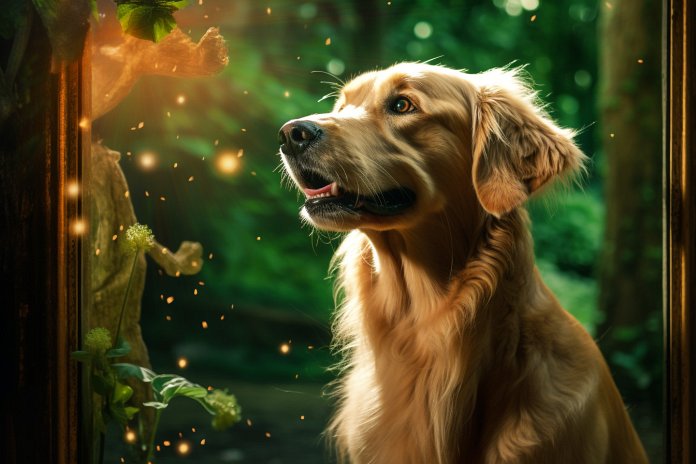
Aesop’s Fable tells the story of a dog who sees his reflection in a pool of water and mistakes it for another dog with a larger piece of meat. This story highlights the fact that dogs do not recognize themselves in mirrors, which has led to the question of how self-recognition develops in humans and animals.
Reactions to Mirrors:
When dogs see their reflection in a mirror, they may have various reactions. Some dogs may briefly glance at the mirror and then walk away, while others may bark, growl, or lunge at their reflection. Fearful dogs may exhibit submissive behaviors like pulling their ears back or backing away. These reactions indicate that dogs are seeing another dog in the mirror but not recognizing themselves.
Lack of Interest in the Reflection:
Dogs generally do not spend much time looking at themselves in the mirror. They may react as if it were another dog but quickly lose interest and move on to other things. Some owners have noticed that once their dog has seen itself in the mirror, it no longer pays attention to its reflection on subsequent encounters. Aggressive or fearful dogs may react differently to the image.
Body Language:
If a dog recognizes itself in the mirror, it may display signs of self-awareness such as staring, being alert, barking, or wagging its tail. Other reactions to look out for include briefly looking at the reflection, walking away, trying to sniff the mirror, barking for a short time, or backing away from the mirror.
The History of Dogs and Their Reflections:
Consciousness, or awareness, is a topic that has been studied by humans for centuries. While humans have a stream of thoughts and self-awareness, it is unclear if dogs have similar experiences. Dogs rely more on their sense of smell to recognize themselves and other dogs. Studies with dogs have shown that they are more interested in familiar smells than their own urine, suggesting that they recognize themselves through smell rather than vision.
The Science of Dogs Recognizing Their Reflections:
Scientists have used the mirror test to study self-consciousness in humans and animals. Puppies and human babies initially react to their reflection as if it were another individual, but as they develop language skills, they begin to recognize themselves. Other animals like chimpanzees, dolphins, elephants, and magpies have also shown signs of self-recognition in mirror tests.
Training Your Dog to Recognize:
Dogs do not need to be trained to recognize themselves in the mirror since they rely more on smell. However, training good sniffing behaviors can be beneficial. It is important to allow dogs to greet each other by sniffing each other’s hind-quarters, as this helps them establish familiarity and avoid fights. When it comes to crotch-sniffing humans, it is best to train the dog to exhibit appropriate behavior and gently redirect them if necessary.
Safety Tips for Recognizing Dogs:
Understand your dog’s territory and how they mark their territory.
Leash your dog in public and be aware of other dogs in the area.
Allow your dog to sniff but prevent them from eating excrement.
Be gentle when your dog is being sniffed to avoid conflicts or bites.
“Dogs may not recognize themselves in the mirror, but they use their sense of smell to identify themselves and others.”

Tips & Things to Know
1️⃣ Dogs do not recognize themselves in the mirror, so don’t expect them to have a self-awareness reaction when they see their reflection.
2️⃣ Dogs may have different reactions to seeing themselves in the mirror, such as briefly looking, walking away, or barking. Pay attention to your dog’s body language to understand their reaction.
3️⃣ Dogs rely on their sense of smell to recognize themselves and other dogs, so allow them to sniff and greet other dogs in a friendly manner. Train your dog to exhibit appropriate behavior when greeting people to avoid uncomfortable situations.
Frequently Asked Questions, Answered ✅
1. Why do dogs react differently when they see themselves in the mirror?
– Dogs react differently because they typically do not recognize themselves in the mirror. They may show signs of aggression, fear, or disinterest instead.
2. How can you tell if your dog recognizes itself in the mirror?
– If your dog stares, barks, wags its tail, or shows signs of alertness when looking at its reflection, it may be recognizing itself in the mirror.
3. Do dogs use their sense of smell to recognize themselves and others?
– Yes, dogs primarily use their sense of smell to recognize themselves and others. They rely on sniffing to establish territory and identify familiar scents.
4. How do scientists test if animals recognize themselves in the mirror?
– Scientists use the mirror test, where they place a mark on the animal’s body and observe its reaction to the mark in the mirror. If the animal shows interest in the mark, it indicates self-recognition.
5. What are some safety tips for recognizing dogs?
– Understand your dog’s territory and its marking signals.
– Leash your dog in public and be aware of other dogs in the park.
– Allow your dog to sniff, but prevent it from eating excrement.
– Be gentle when your dog is being sniffed to avoid potential fights or bites.